Commercial Kitchen Health and Safety Training
VerifiedAdded on 2020/02/14
|14
|2763
|267
AI Summary
This assessment focuses on a chef's responsibilities for ensuring workplace health and safety in a commercial kitchen. It covers topics like identifying hazards, preventing burns, conducting effective training sessions, managing WHS records and reports, and understanding the roles of employees and employers in maintaining a safe work environment.
Contribute Materials
Your contribution can guide someone’s learning journey. Share your
documents today.
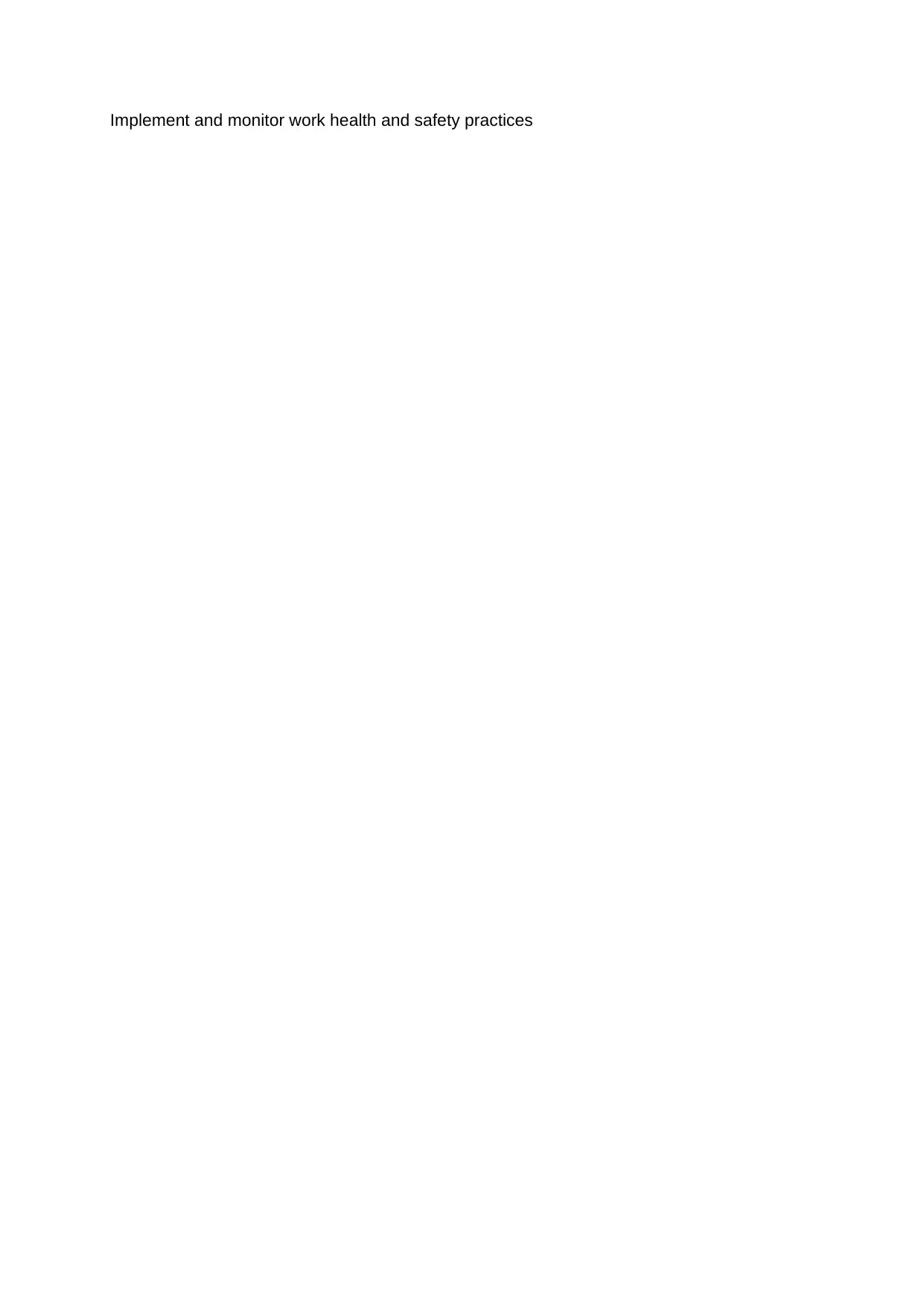
Implement and monitor work health and safety practices
Secure Best Marks with AI Grader
Need help grading? Try our AI Grader for instant feedback on your assignments.
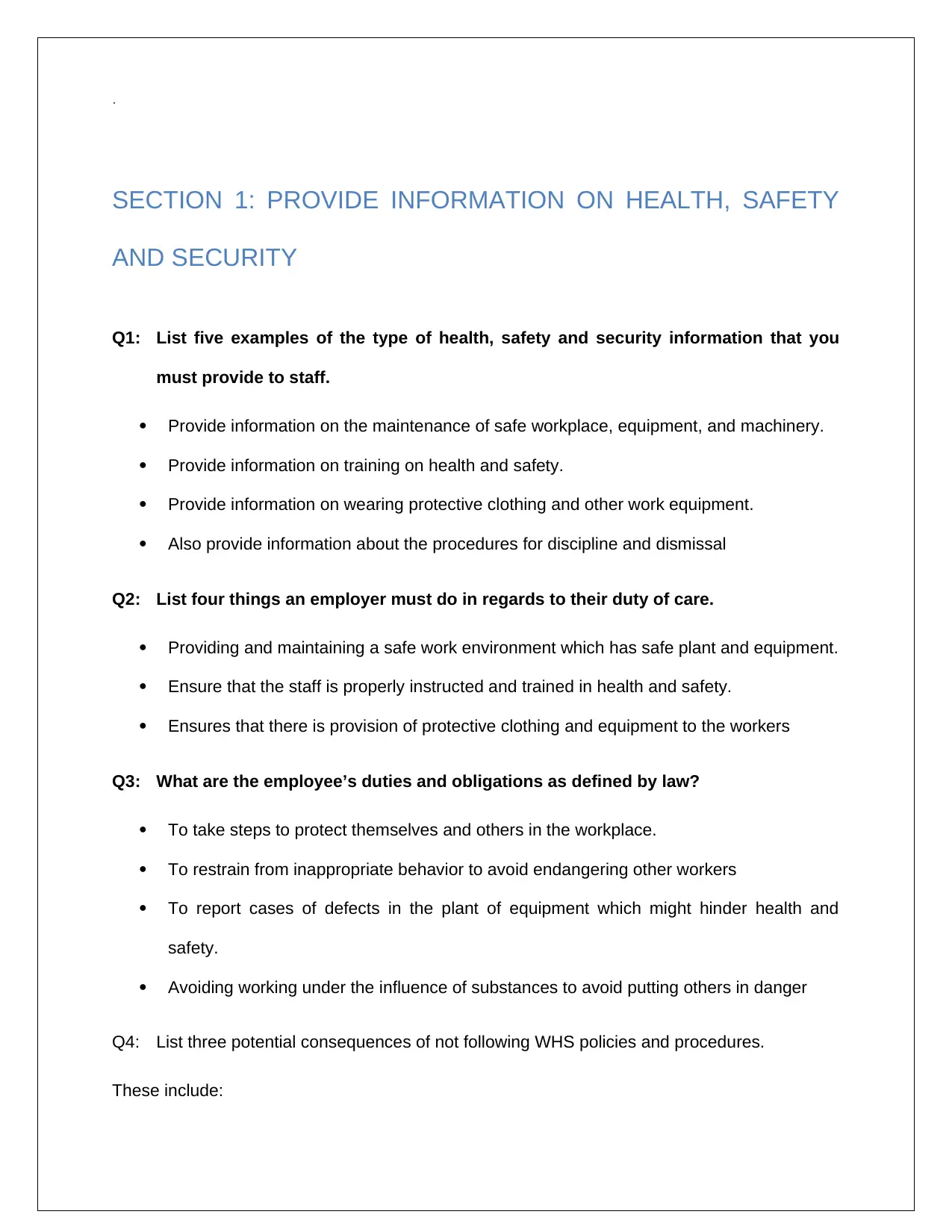
.
SECTION 1: PROVIDE INFORMATION ON HEALTH, SAFETY
AND SECURITY
Q1: List five examples of the type of health, safety and security information that you
must provide to staff.
Provide information on the maintenance of safe workplace, equipment, and machinery.
Provide information on training on health and safety.
Provide information on wearing protective clothing and other work equipment.
Also provide information about the procedures for discipline and dismissal
Q2: List four things an employer must do in regards to their duty of care.
Providing and maintaining a safe work environment which has safe plant and equipment.
Ensure that the staff is properly instructed and trained in health and safety.
Ensures that there is provision of protective clothing and equipment to the workers
Q3: What are the employee’s duties and obligations as defined by law?
To take steps to protect themselves and others in the workplace.
To restrain from inappropriate behavior to avoid endangering other workers
To report cases of defects in the plant of equipment which might hinder health and
safety.
Avoiding working under the influence of substances to avoid putting others in danger
Q4: List three potential consequences of not following WHS policies and procedures.
These include:
SECTION 1: PROVIDE INFORMATION ON HEALTH, SAFETY
AND SECURITY
Q1: List five examples of the type of health, safety and security information that you
must provide to staff.
Provide information on the maintenance of safe workplace, equipment, and machinery.
Provide information on training on health and safety.
Provide information on wearing protective clothing and other work equipment.
Also provide information about the procedures for discipline and dismissal
Q2: List four things an employer must do in regards to their duty of care.
Providing and maintaining a safe work environment which has safe plant and equipment.
Ensure that the staff is properly instructed and trained in health and safety.
Ensures that there is provision of protective clothing and equipment to the workers
Q3: What are the employee’s duties and obligations as defined by law?
To take steps to protect themselves and others in the workplace.
To restrain from inappropriate behavior to avoid endangering other workers
To report cases of defects in the plant of equipment which might hinder health and
safety.
Avoiding working under the influence of substances to avoid putting others in danger
Q4: List three potential consequences of not following WHS policies and procedures.
These include:
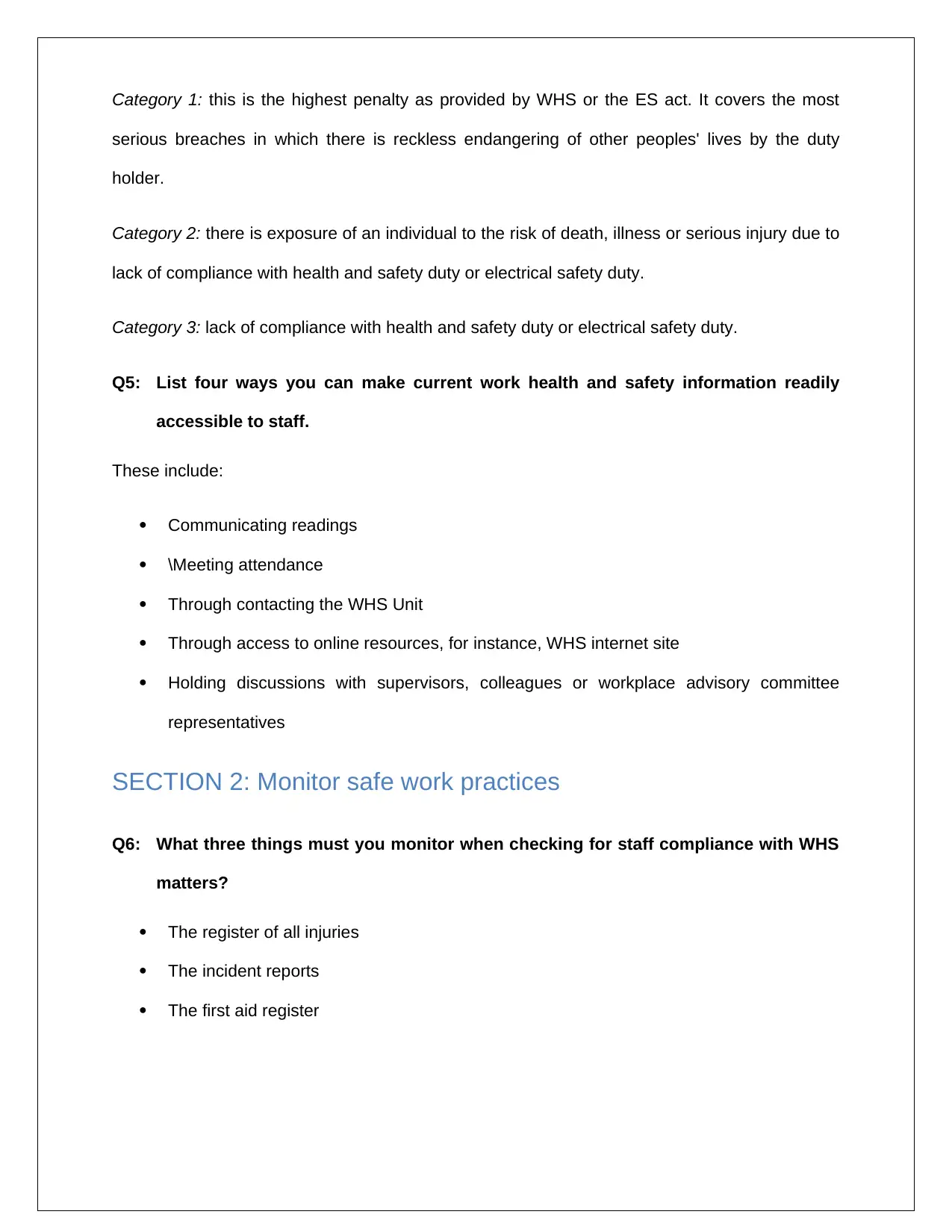
Category 1: this is the highest penalty as provided by WHS or the ES act. It covers the most
serious breaches in which there is reckless endangering of other peoples' lives by the duty
holder.
Category 2: there is exposure of an individual to the risk of death, illness or serious injury due to
lack of compliance with health and safety duty or electrical safety duty.
Category 3: lack of compliance with health and safety duty or electrical safety duty.
Q5: List four ways you can make current work health and safety information readily
accessible to staff.
These include:
Communicating readings
\Meeting attendance
Through contacting the WHS Unit
Through access to online resources, for instance, WHS internet site
Holding discussions with supervisors, colleagues or workplace advisory committee
representatives
SECTION 2: Monitor safe work practices
Q6: What three things must you monitor when checking for staff compliance with WHS
matters?
The register of all injuries
The incident reports
The first aid register
serious breaches in which there is reckless endangering of other peoples' lives by the duty
holder.
Category 2: there is exposure of an individual to the risk of death, illness or serious injury due to
lack of compliance with health and safety duty or electrical safety duty.
Category 3: lack of compliance with health and safety duty or electrical safety duty.
Q5: List four ways you can make current work health and safety information readily
accessible to staff.
These include:
Communicating readings
\Meeting attendance
Through contacting the WHS Unit
Through access to online resources, for instance, WHS internet site
Holding discussions with supervisors, colleagues or workplace advisory committee
representatives
SECTION 2: Monitor safe work practices
Q6: What three things must you monitor when checking for staff compliance with WHS
matters?
The register of all injuries
The incident reports
The first aid register
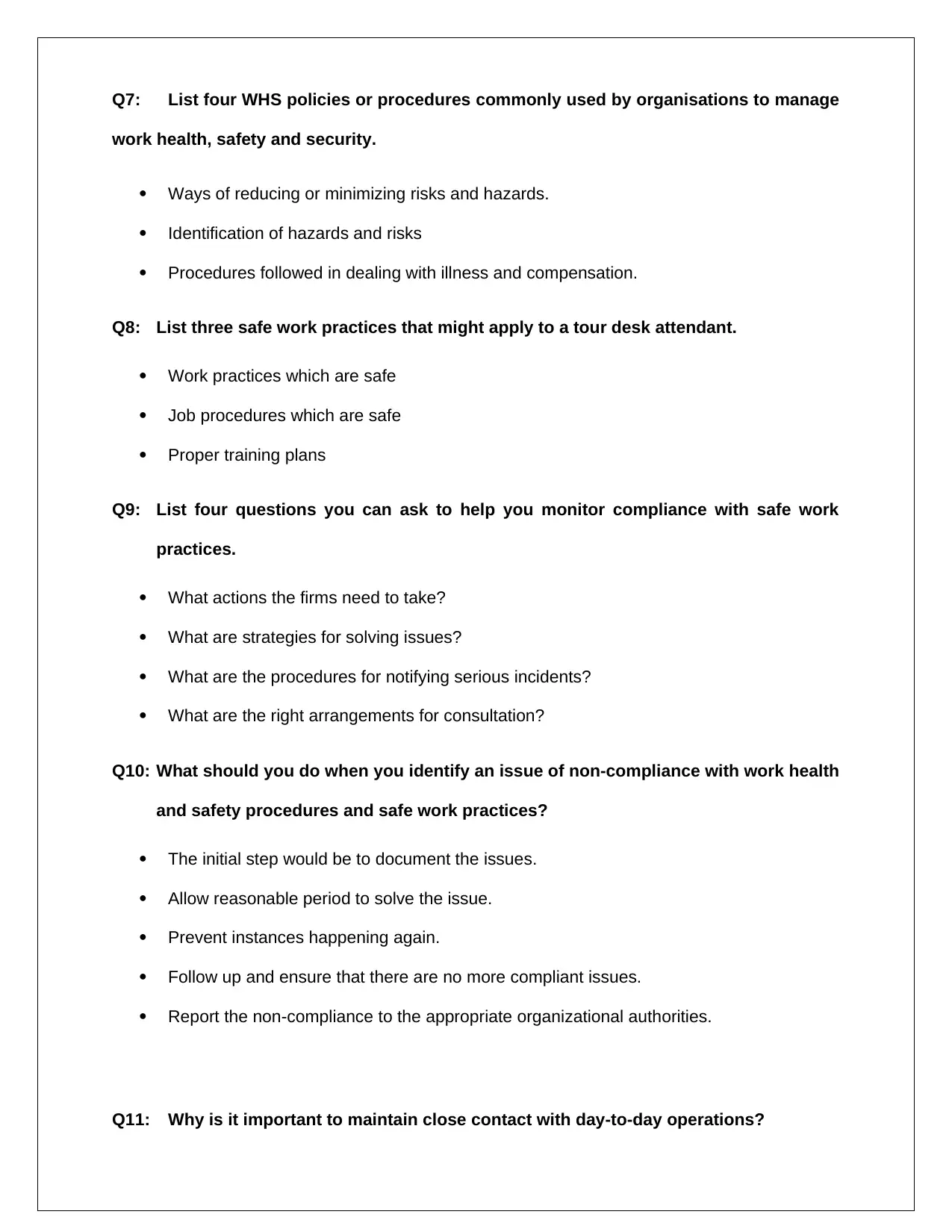
Q7: List four WHS policies or procedures commonly used by organisations to manage
work health, safety and security.
Ways of reducing or minimizing risks and hazards.
Identification of hazards and risks
Procedures followed in dealing with illness and compensation.
Q8: List three safe work practices that might apply to a tour desk attendant.
Work practices which are safe
Job procedures which are safe
Proper training plans
Q9: List four questions you can ask to help you monitor compliance with safe work
practices.
What actions the firms need to take?
What are strategies for solving issues?
What are the procedures for notifying serious incidents?
What are the right arrangements for consultation?
Q10: What should you do when you identify an issue of non-compliance with work health
and safety procedures and safe work practices?
The initial step would be to document the issues.
Allow reasonable period to solve the issue.
Prevent instances happening again.
Follow up and ensure that there are no more compliant issues.
Report the non-compliance to the appropriate organizational authorities.
Q11: Why is it important to maintain close contact with day-to-day operations?
work health, safety and security.
Ways of reducing or minimizing risks and hazards.
Identification of hazards and risks
Procedures followed in dealing with illness and compensation.
Q8: List three safe work practices that might apply to a tour desk attendant.
Work practices which are safe
Job procedures which are safe
Proper training plans
Q9: List four questions you can ask to help you monitor compliance with safe work
practices.
What actions the firms need to take?
What are strategies for solving issues?
What are the procedures for notifying serious incidents?
What are the right arrangements for consultation?
Q10: What should you do when you identify an issue of non-compliance with work health
and safety procedures and safe work practices?
The initial step would be to document the issues.
Allow reasonable period to solve the issue.
Prevent instances happening again.
Follow up and ensure that there are no more compliant issues.
Report the non-compliance to the appropriate organizational authorities.
Q11: Why is it important to maintain close contact with day-to-day operations?
Secure Best Marks with AI Grader
Need help grading? Try our AI Grader for instant feedback on your assignments.
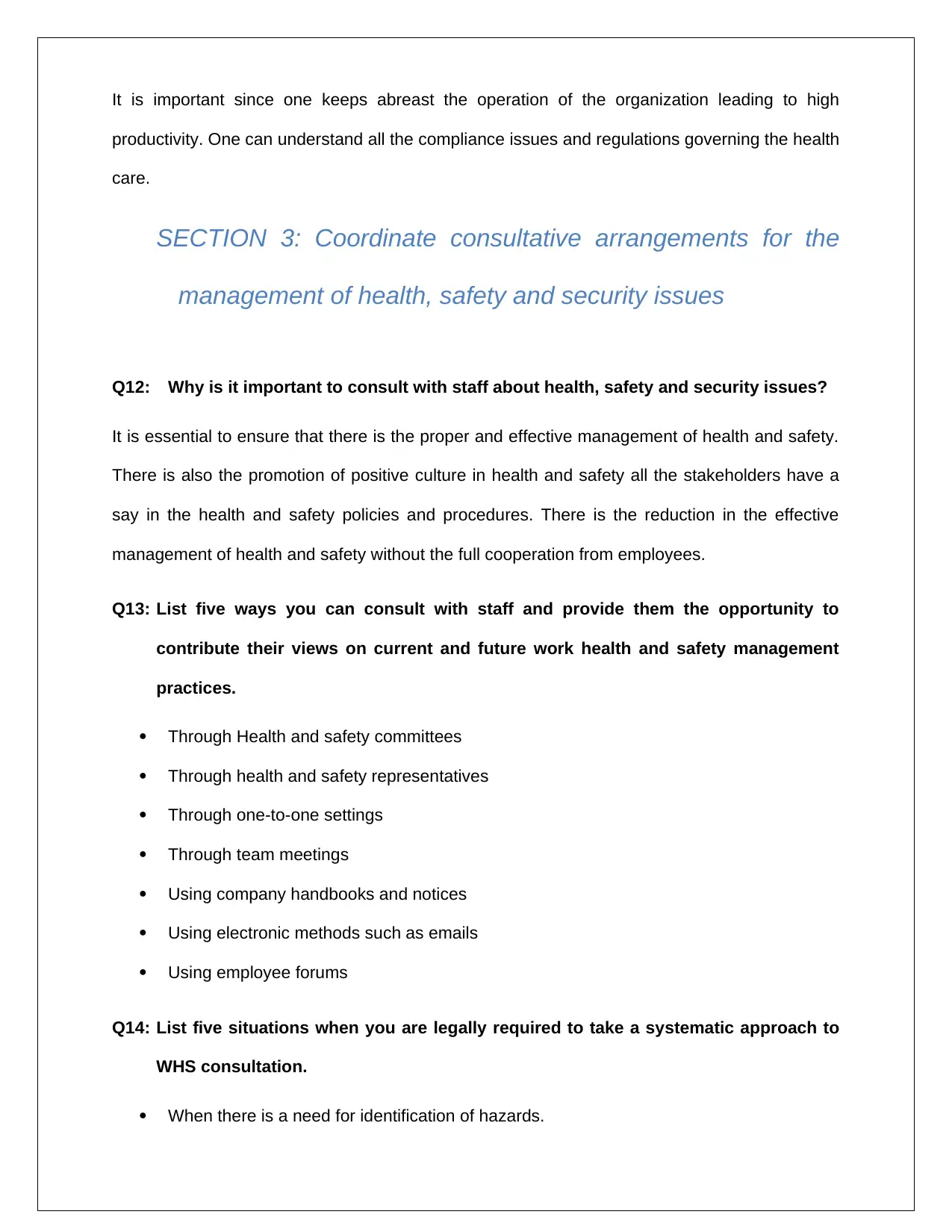
It is important since one keeps abreast the operation of the organization leading to high
productivity. One can understand all the compliance issues and regulations governing the health
care.
SECTION 3: Coordinate consultative arrangements for the
management of health, safety and security issues
Q12: Why is it important to consult with staff about health, safety and security issues?
It is essential to ensure that there is the proper and effective management of health and safety.
There is also the promotion of positive culture in health and safety all the stakeholders have a
say in the health and safety policies and procedures. There is the reduction in the effective
management of health and safety without the full cooperation from employees.
Q13: List five ways you can consult with staff and provide them the opportunity to
contribute their views on current and future work health and safety management
practices.
Through Health and safety committees
Through health and safety representatives
Through one-to-one settings
Through team meetings
Using company handbooks and notices
Using electronic methods such as emails
Using employee forums
Q14: List five situations when you are legally required to take a systematic approach to
WHS consultation.
When there is a need for identification of hazards.
productivity. One can understand all the compliance issues and regulations governing the health
care.
SECTION 3: Coordinate consultative arrangements for the
management of health, safety and security issues
Q12: Why is it important to consult with staff about health, safety and security issues?
It is essential to ensure that there is the proper and effective management of health and safety.
There is also the promotion of positive culture in health and safety all the stakeholders have a
say in the health and safety policies and procedures. There is the reduction in the effective
management of health and safety without the full cooperation from employees.
Q13: List five ways you can consult with staff and provide them the opportunity to
contribute their views on current and future work health and safety management
practices.
Through Health and safety committees
Through health and safety representatives
Through one-to-one settings
Through team meetings
Using company handbooks and notices
Using electronic methods such as emails
Using employee forums
Q14: List five situations when you are legally required to take a systematic approach to
WHS consultation.
When there is a need for identification of hazards.
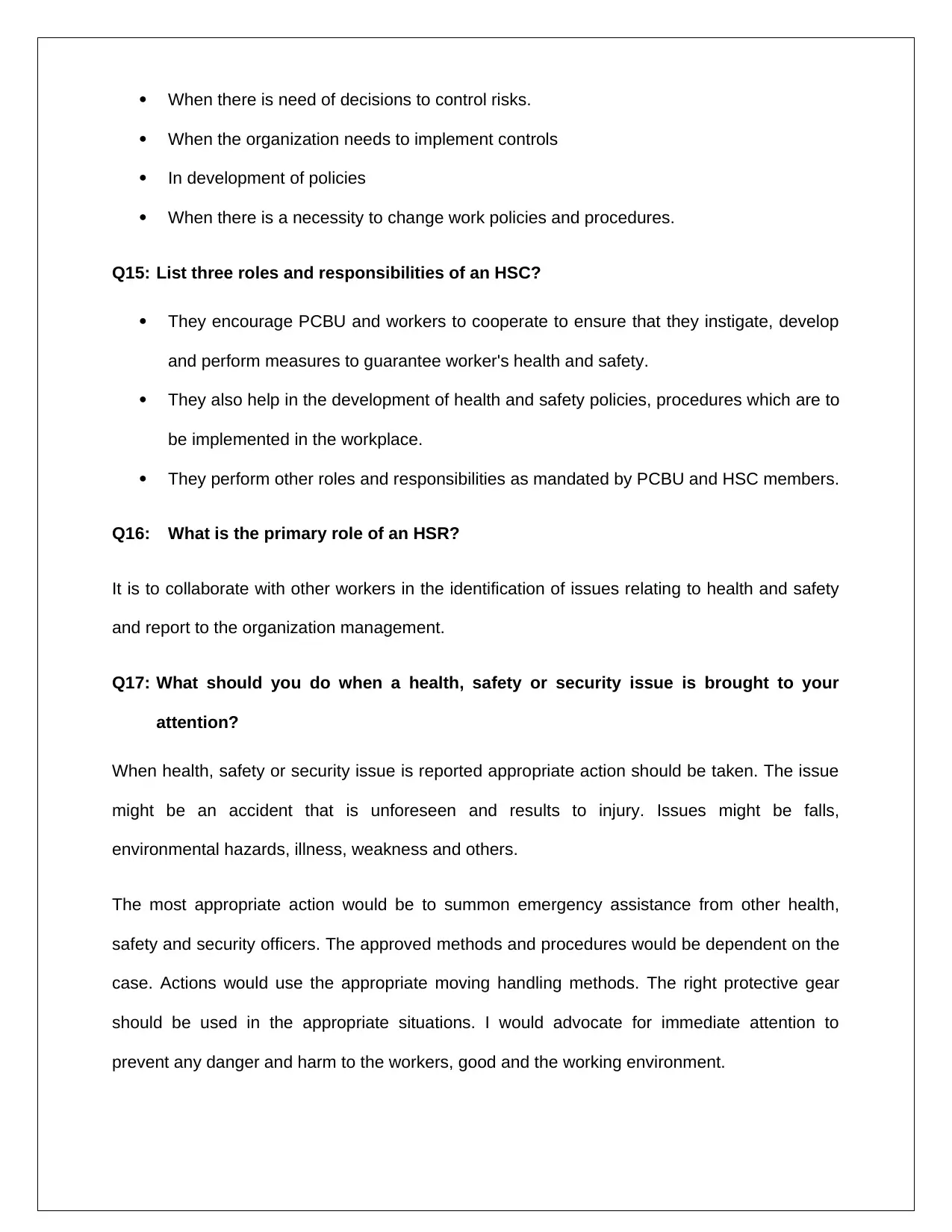
When there is need of decisions to control risks.
When the organization needs to implement controls
In development of policies
When there is a necessity to change work policies and procedures.
Q15: List three roles and responsibilities of an HSC?
They encourage PCBU and workers to cooperate to ensure that they instigate, develop
and perform measures to guarantee worker's health and safety.
They also help in the development of health and safety policies, procedures which are to
be implemented in the workplace.
They perform other roles and responsibilities as mandated by PCBU and HSC members.
Q16: What is the primary role of an HSR?
It is to collaborate with other workers in the identification of issues relating to health and safety
and report to the organization management.
Q17: What should you do when a health, safety or security issue is brought to your
attention?
When health, safety or security issue is reported appropriate action should be taken. The issue
might be an accident that is unforeseen and results to injury. Issues might be falls,
environmental hazards, illness, weakness and others.
The most appropriate action would be to summon emergency assistance from other health,
safety and security officers. The approved methods and procedures would be dependent on the
case. Actions would use the appropriate moving handling methods. The right protective gear
should be used in the appropriate situations. I would advocate for immediate attention to
prevent any danger and harm to the workers, good and the working environment.
When the organization needs to implement controls
In development of policies
When there is a necessity to change work policies and procedures.
Q15: List three roles and responsibilities of an HSC?
They encourage PCBU and workers to cooperate to ensure that they instigate, develop
and perform measures to guarantee worker's health and safety.
They also help in the development of health and safety policies, procedures which are to
be implemented in the workplace.
They perform other roles and responsibilities as mandated by PCBU and HSC members.
Q16: What is the primary role of an HSR?
It is to collaborate with other workers in the identification of issues relating to health and safety
and report to the organization management.
Q17: What should you do when a health, safety or security issue is brought to your
attention?
When health, safety or security issue is reported appropriate action should be taken. The issue
might be an accident that is unforeseen and results to injury. Issues might be falls,
environmental hazards, illness, weakness and others.
The most appropriate action would be to summon emergency assistance from other health,
safety and security officers. The approved methods and procedures would be dependent on the
case. Actions would use the appropriate moving handling methods. The right protective gear
should be used in the appropriate situations. I would advocate for immediate attention to
prevent any danger and harm to the workers, good and the working environment.
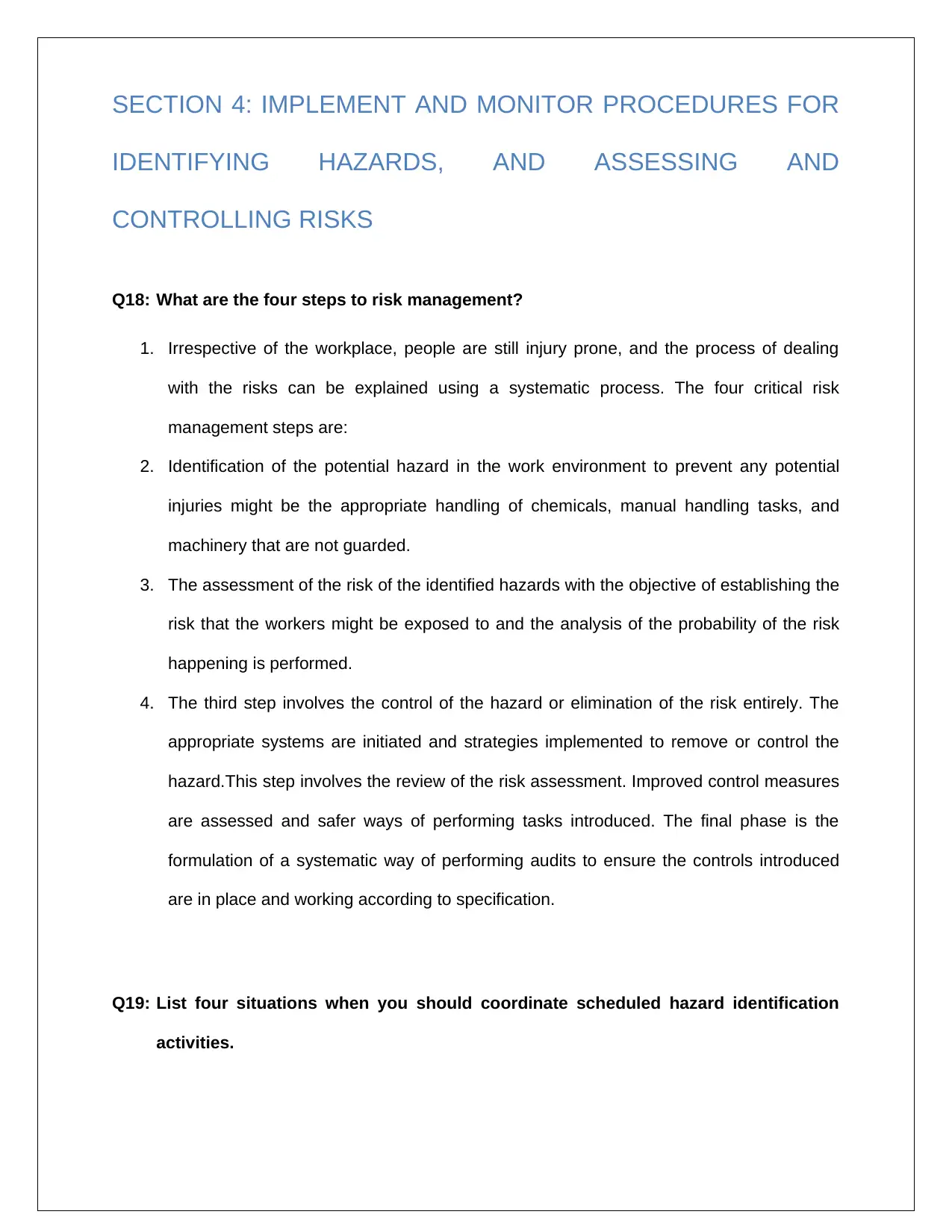
SECTION 4: IMPLEMENT AND MONITOR PROCEDURES FOR
IDENTIFYING HAZARDS, AND ASSESSING AND
CONTROLLING RISKS
Q18: What are the four steps to risk management?
1. Irrespective of the workplace, people are still injury prone, and the process of dealing
with the risks can be explained using a systematic process. The four critical risk
management steps are:
2. Identification of the potential hazard in the work environment to prevent any potential
injuries might be the appropriate handling of chemicals, manual handling tasks, and
machinery that are not guarded.
3. The assessment of the risk of the identified hazards with the objective of establishing the
risk that the workers might be exposed to and the analysis of the probability of the risk
happening is performed.
4. The third step involves the control of the hazard or elimination of the risk entirely. The
appropriate systems are initiated and strategies implemented to remove or control the
hazard.This step involves the review of the risk assessment. Improved control measures
are assessed and safer ways of performing tasks introduced. The final phase is the
formulation of a systematic way of performing audits to ensure the controls introduced
are in place and working according to specification.
Q19: List four situations when you should coordinate scheduled hazard identification
activities.
IDENTIFYING HAZARDS, AND ASSESSING AND
CONTROLLING RISKS
Q18: What are the four steps to risk management?
1. Irrespective of the workplace, people are still injury prone, and the process of dealing
with the risks can be explained using a systematic process. The four critical risk
management steps are:
2. Identification of the potential hazard in the work environment to prevent any potential
injuries might be the appropriate handling of chemicals, manual handling tasks, and
machinery that are not guarded.
3. The assessment of the risk of the identified hazards with the objective of establishing the
risk that the workers might be exposed to and the analysis of the probability of the risk
happening is performed.
4. The third step involves the control of the hazard or elimination of the risk entirely. The
appropriate systems are initiated and strategies implemented to remove or control the
hazard.This step involves the review of the risk assessment. Improved control measures
are assessed and safer ways of performing tasks introduced. The final phase is the
formulation of a systematic way of performing audits to ensure the controls introduced
are in place and working according to specification.
Q19: List four situations when you should coordinate scheduled hazard identification
activities.
Paraphrase This Document
Need a fresh take? Get an instant paraphrase of this document with our AI Paraphraser
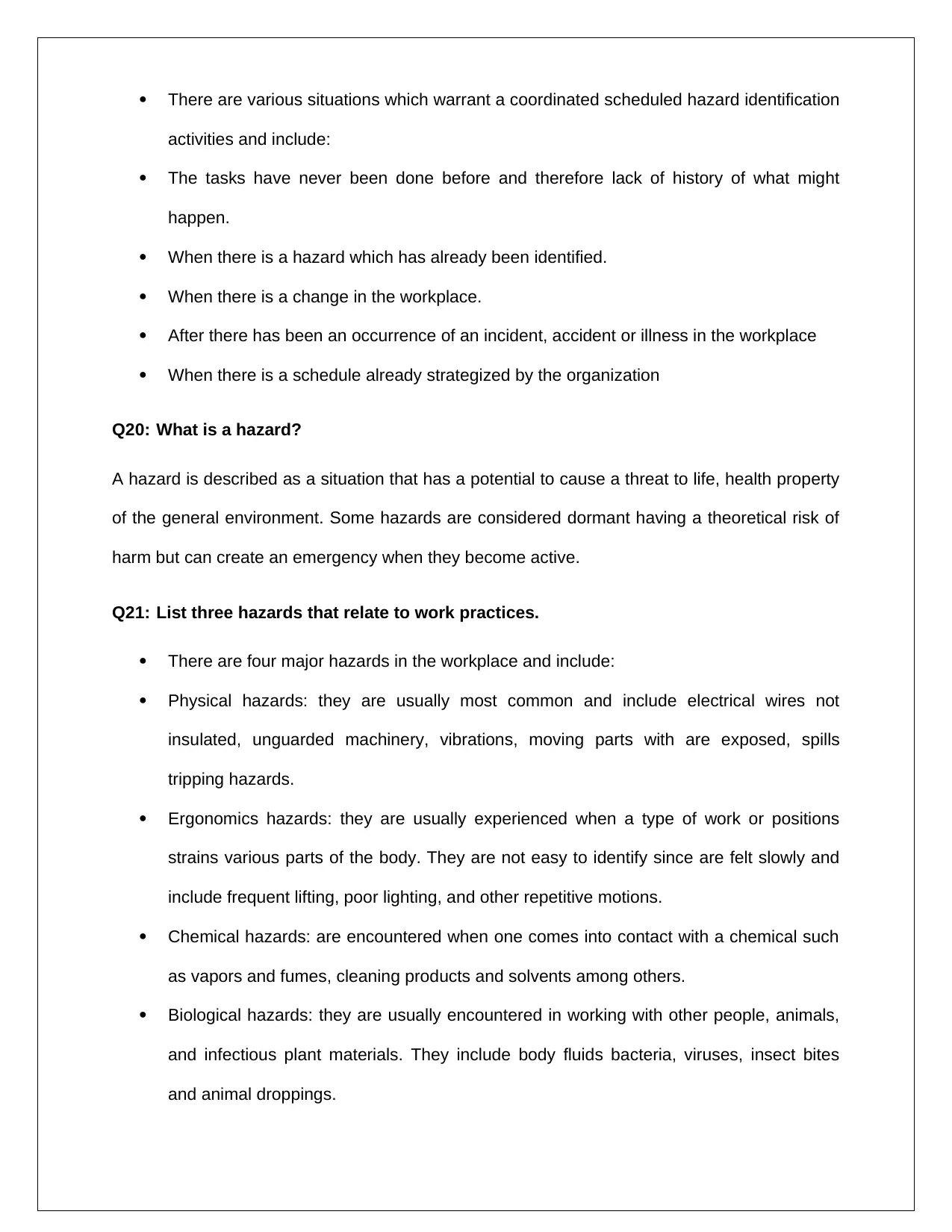
There are various situations which warrant a coordinated scheduled hazard identification
activities and include:
The tasks have never been done before and therefore lack of history of what might
happen.
When there is a hazard which has already been identified.
When there is a change in the workplace.
After there has been an occurrence of an incident, accident or illness in the workplace
When there is a schedule already strategized by the organization
Q20: What is a hazard?
A hazard is described as a situation that has a potential to cause a threat to life, health property
of the general environment. Some hazards are considered dormant having a theoretical risk of
harm but can create an emergency when they become active.
Q21: List three hazards that relate to work practices.
There are four major hazards in the workplace and include:
Physical hazards: they are usually most common and include electrical wires not
insulated, unguarded machinery, vibrations, moving parts with are exposed, spills
tripping hazards.
Ergonomics hazards: they are usually experienced when a type of work or positions
strains various parts of the body. They are not easy to identify since are felt slowly and
include frequent lifting, poor lighting, and other repetitive motions.
Chemical hazards: are encountered when one comes into contact with a chemical such
as vapors and fumes, cleaning products and solvents among others.
Biological hazards: they are usually encountered in working with other people, animals,
and infectious plant materials. They include body fluids bacteria, viruses, insect bites
and animal droppings.
activities and include:
The tasks have never been done before and therefore lack of history of what might
happen.
When there is a hazard which has already been identified.
When there is a change in the workplace.
After there has been an occurrence of an incident, accident or illness in the workplace
When there is a schedule already strategized by the organization
Q20: What is a hazard?
A hazard is described as a situation that has a potential to cause a threat to life, health property
of the general environment. Some hazards are considered dormant having a theoretical risk of
harm but can create an emergency when they become active.
Q21: List three hazards that relate to work practices.
There are four major hazards in the workplace and include:
Physical hazards: they are usually most common and include electrical wires not
insulated, unguarded machinery, vibrations, moving parts with are exposed, spills
tripping hazards.
Ergonomics hazards: they are usually experienced when a type of work or positions
strains various parts of the body. They are not easy to identify since are felt slowly and
include frequent lifting, poor lighting, and other repetitive motions.
Chemical hazards: are encountered when one comes into contact with a chemical such
as vapors and fumes, cleaning products and solvents among others.
Biological hazards: they are usually encountered in working with other people, animals,
and infectious plant materials. They include body fluids bacteria, viruses, insect bites
and animal droppings.
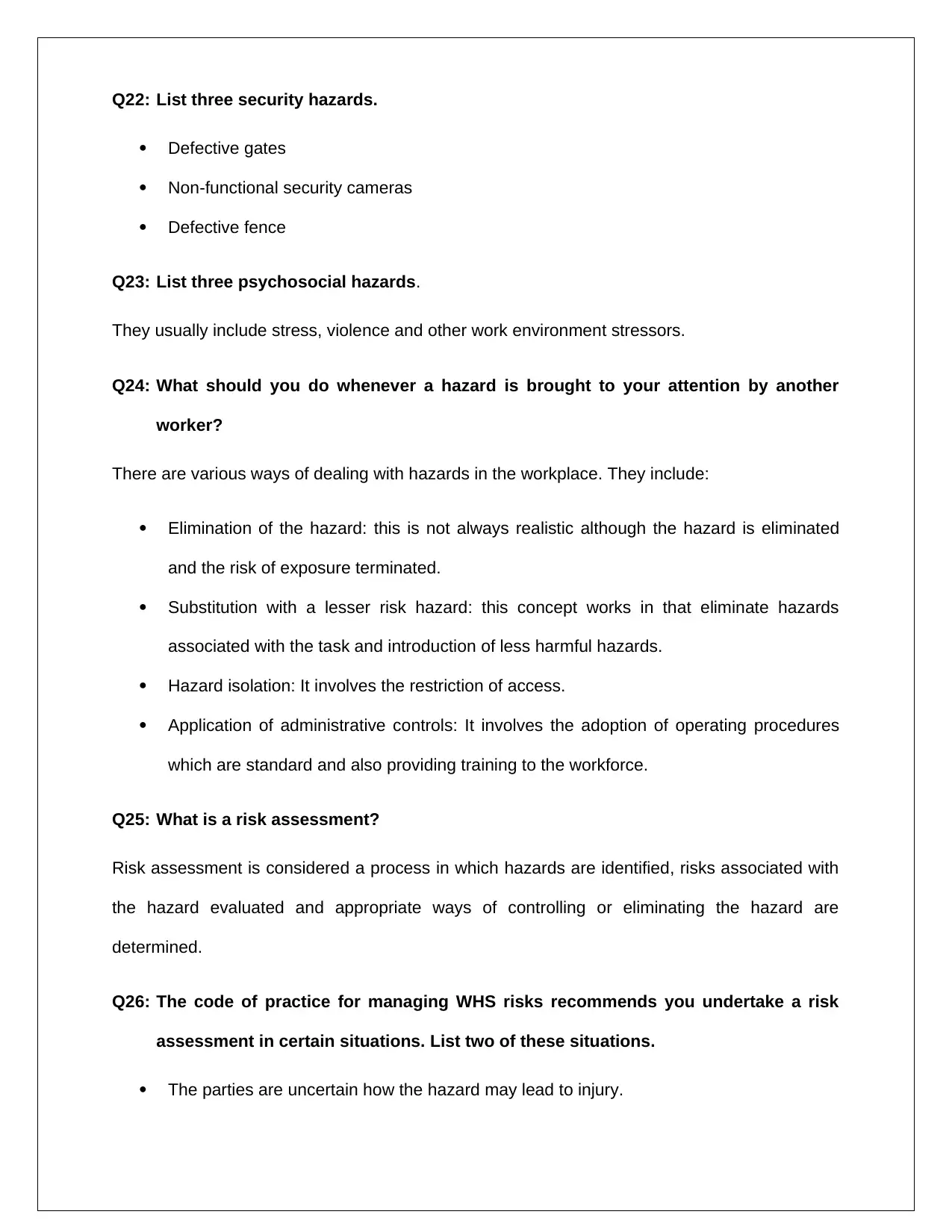
Q22: List three security hazards.
Defective gates
Non-functional security cameras
Defective fence
Q23: List three psychosocial hazards.
They usually include stress, violence and other work environment stressors.
Q24: What should you do whenever a hazard is brought to your attention by another
worker?
There are various ways of dealing with hazards in the workplace. They include:
Elimination of the hazard: this is not always realistic although the hazard is eliminated
and the risk of exposure terminated.
Substitution with a lesser risk hazard: this concept works in that eliminate hazards
associated with the task and introduction of less harmful hazards.
Hazard isolation: It involves the restriction of access.
Application of administrative controls: It involves the adoption of operating procedures
which are standard and also providing training to the workforce.
Q25: What is a risk assessment?
Risk assessment is considered a process in which hazards are identified, risks associated with
the hazard evaluated and appropriate ways of controlling or eliminating the hazard are
determined.
Q26: The code of practice for managing WHS risks recommends you undertake a risk
assessment in certain situations. List two of these situations.
The parties are uncertain how the hazard may lead to injury.
Defective gates
Non-functional security cameras
Defective fence
Q23: List three psychosocial hazards.
They usually include stress, violence and other work environment stressors.
Q24: What should you do whenever a hazard is brought to your attention by another
worker?
There are various ways of dealing with hazards in the workplace. They include:
Elimination of the hazard: this is not always realistic although the hazard is eliminated
and the risk of exposure terminated.
Substitution with a lesser risk hazard: this concept works in that eliminate hazards
associated with the task and introduction of less harmful hazards.
Hazard isolation: It involves the restriction of access.
Application of administrative controls: It involves the adoption of operating procedures
which are standard and also providing training to the workforce.
Q25: What is a risk assessment?
Risk assessment is considered a process in which hazards are identified, risks associated with
the hazard evaluated and appropriate ways of controlling or eliminating the hazard are
determined.
Q26: The code of practice for managing WHS risks recommends you undertake a risk
assessment in certain situations. List two of these situations.
The parties are uncertain how the hazard may lead to injury.
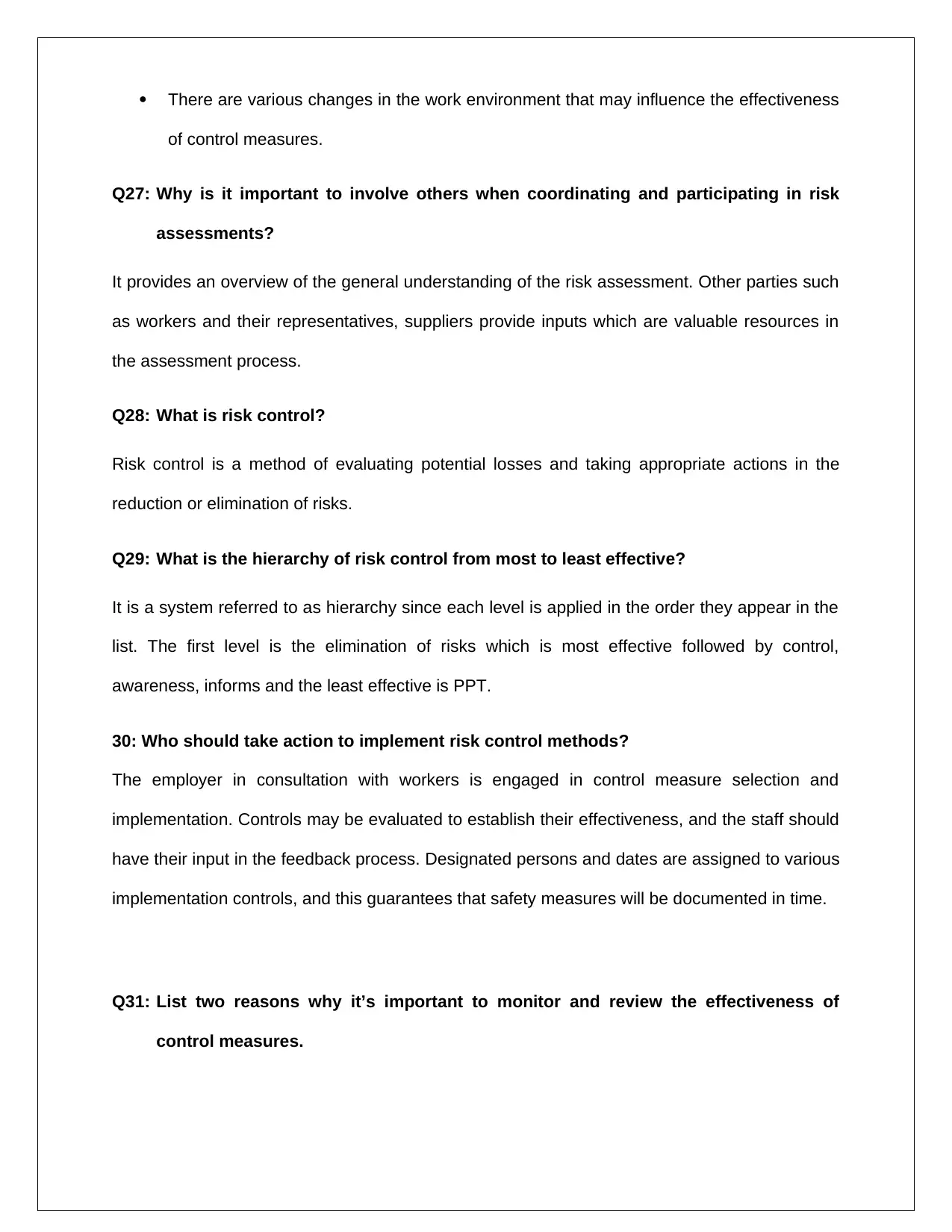
There are various changes in the work environment that may influence the effectiveness
of control measures.
Q27: Why is it important to involve others when coordinating and participating in risk
assessments?
It provides an overview of the general understanding of the risk assessment. Other parties such
as workers and their representatives, suppliers provide inputs which are valuable resources in
the assessment process.
Q28: What is risk control?
Risk control is a method of evaluating potential losses and taking appropriate actions in the
reduction or elimination of risks.
Q29: What is the hierarchy of risk control from most to least effective?
It is a system referred to as hierarchy since each level is applied in the order they appear in the
list. The first level is the elimination of risks which is most effective followed by control,
awareness, informs and the least effective is PPT.
30: Who should take action to implement risk control methods?
The employer in consultation with workers is engaged in control measure selection and
implementation. Controls may be evaluated to establish their effectiveness, and the staff should
have their input in the feedback process. Designated persons and dates are assigned to various
implementation controls, and this guarantees that safety measures will be documented in time.
Q31: List two reasons why it’s important to monitor and review the effectiveness of
control measures.
of control measures.
Q27: Why is it important to involve others when coordinating and participating in risk
assessments?
It provides an overview of the general understanding of the risk assessment. Other parties such
as workers and their representatives, suppliers provide inputs which are valuable resources in
the assessment process.
Q28: What is risk control?
Risk control is a method of evaluating potential losses and taking appropriate actions in the
reduction or elimination of risks.
Q29: What is the hierarchy of risk control from most to least effective?
It is a system referred to as hierarchy since each level is applied in the order they appear in the
list. The first level is the elimination of risks which is most effective followed by control,
awareness, informs and the least effective is PPT.
30: Who should take action to implement risk control methods?
The employer in consultation with workers is engaged in control measure selection and
implementation. Controls may be evaluated to establish their effectiveness, and the staff should
have their input in the feedback process. Designated persons and dates are assigned to various
implementation controls, and this guarantees that safety measures will be documented in time.
Q31: List two reasons why it’s important to monitor and review the effectiveness of
control measures.
Secure Best Marks with AI Grader
Need help grading? Try our AI Grader for instant feedback on your assignments.
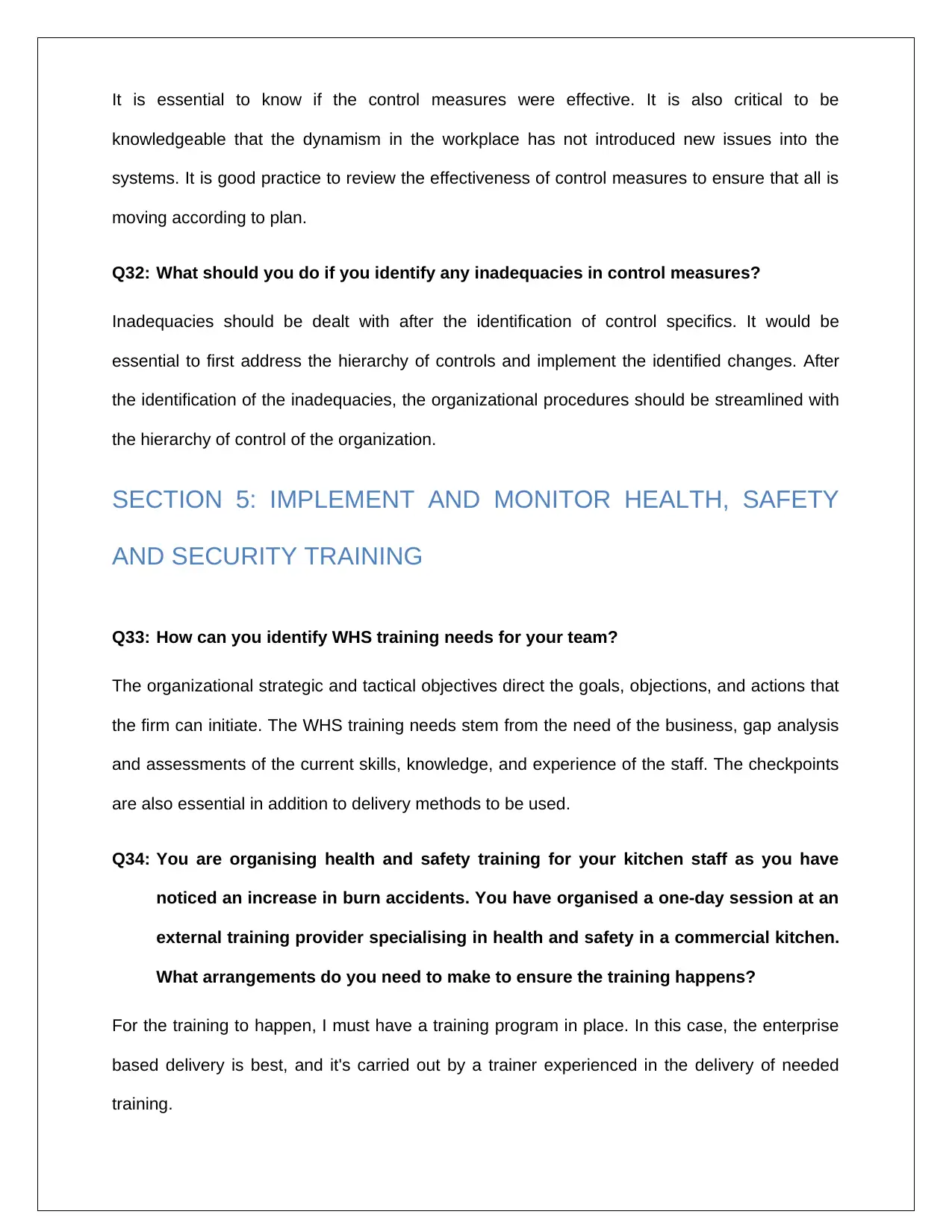
It is essential to know if the control measures were effective. It is also critical to be
knowledgeable that the dynamism in the workplace has not introduced new issues into the
systems. It is good practice to review the effectiveness of control measures to ensure that all is
moving according to plan.
Q32: What should you do if you identify any inadequacies in control measures?
Inadequacies should be dealt with after the identification of control specifics. It would be
essential to first address the hierarchy of controls and implement the identified changes. After
the identification of the inadequacies, the organizational procedures should be streamlined with
the hierarchy of control of the organization.
SECTION 5: IMPLEMENT AND MONITOR HEALTH, SAFETY
AND SECURITY TRAINING
Q33: How can you identify WHS training needs for your team?
The organizational strategic and tactical objectives direct the goals, objections, and actions that
the firm can initiate. The WHS training needs stem from the need of the business, gap analysis
and assessments of the current skills, knowledge, and experience of the staff. The checkpoints
are also essential in addition to delivery methods to be used.
Q34: You are organising health and safety training for your kitchen staff as you have
noticed an increase in burn accidents. You have organised a one-day session at an
external training provider specialising in health and safety in a commercial kitchen.
What arrangements do you need to make to ensure the training happens?
For the training to happen, I must have a training program in place. In this case, the enterprise
based delivery is best, and it's carried out by a trainer experienced in the delivery of needed
training.
knowledgeable that the dynamism in the workplace has not introduced new issues into the
systems. It is good practice to review the effectiveness of control measures to ensure that all is
moving according to plan.
Q32: What should you do if you identify any inadequacies in control measures?
Inadequacies should be dealt with after the identification of control specifics. It would be
essential to first address the hierarchy of controls and implement the identified changes. After
the identification of the inadequacies, the organizational procedures should be streamlined with
the hierarchy of control of the organization.
SECTION 5: IMPLEMENT AND MONITOR HEALTH, SAFETY
AND SECURITY TRAINING
Q33: How can you identify WHS training needs for your team?
The organizational strategic and tactical objectives direct the goals, objections, and actions that
the firm can initiate. The WHS training needs stem from the need of the business, gap analysis
and assessments of the current skills, knowledge, and experience of the staff. The checkpoints
are also essential in addition to delivery methods to be used.
Q34: You are organising health and safety training for your kitchen staff as you have
noticed an increase in burn accidents. You have organised a one-day session at an
external training provider specialising in health and safety in a commercial kitchen.
What arrangements do you need to make to ensure the training happens?
For the training to happen, I must have a training program in place. In this case, the enterprise
based delivery is best, and it's carried out by a trainer experienced in the delivery of needed
training.
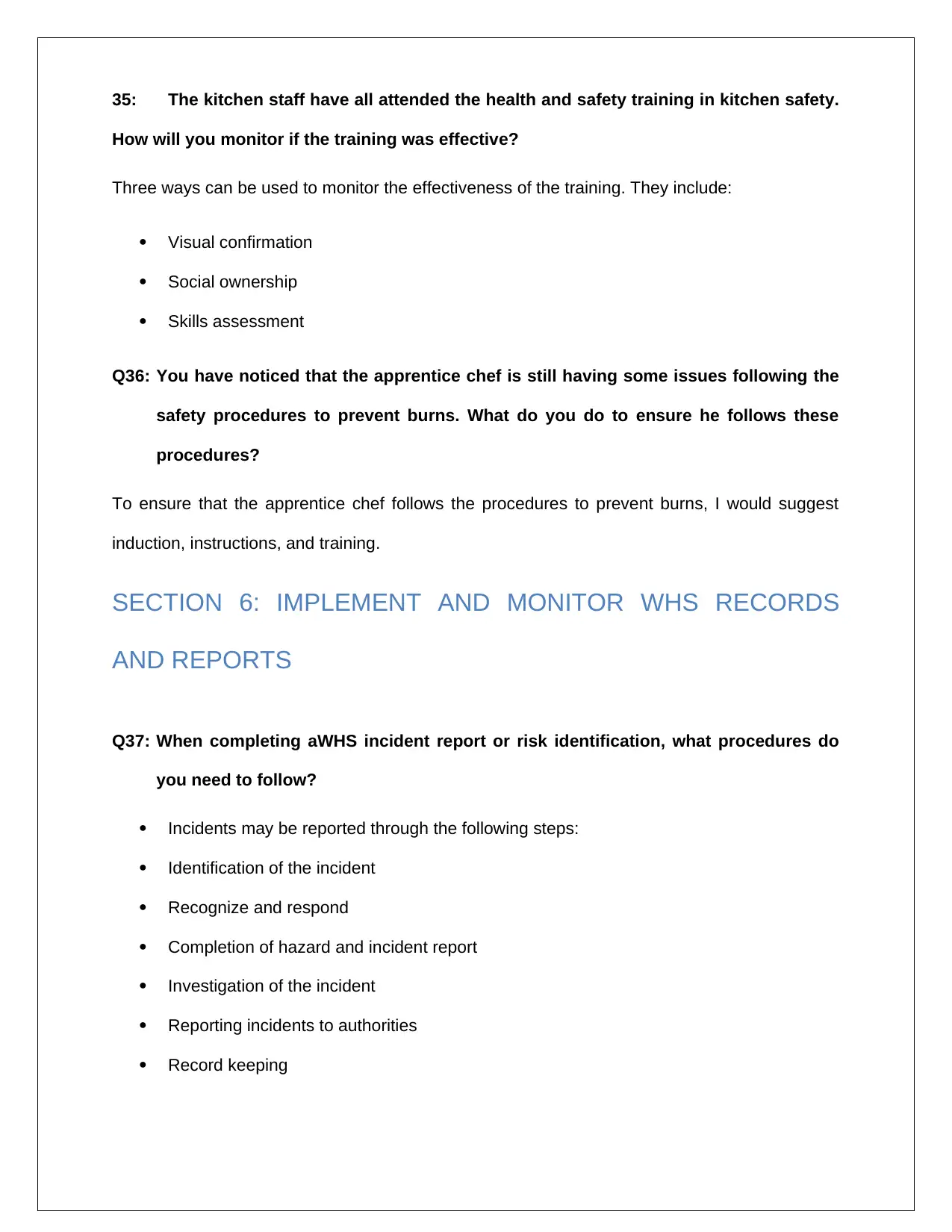
35: The kitchen staff have all attended the health and safety training in kitchen safety.
How will you monitor if the training was effective?
Three ways can be used to monitor the effectiveness of the training. They include:
Visual confirmation
Social ownership
Skills assessment
Q36: You have noticed that the apprentice chef is still having some issues following the
safety procedures to prevent burns. What do you do to ensure he follows these
procedures?
To ensure that the apprentice chef follows the procedures to prevent burns, I would suggest
induction, instructions, and training.
SECTION 6: IMPLEMENT AND MONITOR WHS RECORDS
AND REPORTS
Q37: When completing aWHS incident report or risk identification, what procedures do
you need to follow?
Incidents may be reported through the following steps:
Identification of the incident
Recognize and respond
Completion of hazard and incident report
Investigation of the incident
Reporting incidents to authorities
Record keeping
How will you monitor if the training was effective?
Three ways can be used to monitor the effectiveness of the training. They include:
Visual confirmation
Social ownership
Skills assessment
Q36: You have noticed that the apprentice chef is still having some issues following the
safety procedures to prevent burns. What do you do to ensure he follows these
procedures?
To ensure that the apprentice chef follows the procedures to prevent burns, I would suggest
induction, instructions, and training.
SECTION 6: IMPLEMENT AND MONITOR WHS RECORDS
AND REPORTS
Q37: When completing aWHS incident report or risk identification, what procedures do
you need to follow?
Incidents may be reported through the following steps:
Identification of the incident
Recognize and respond
Completion of hazard and incident report
Investigation of the incident
Reporting incidents to authorities
Record keeping
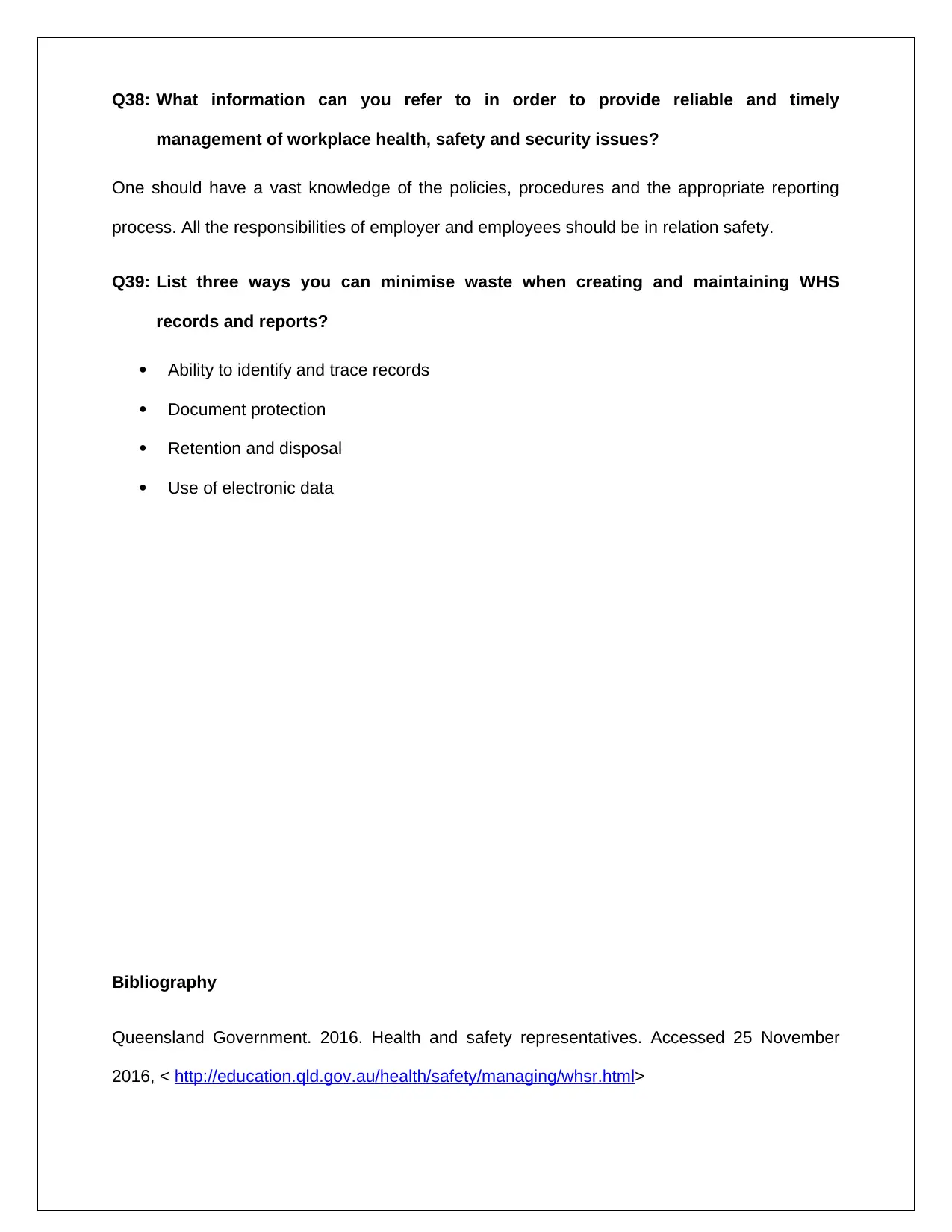
Q38: What information can you refer to in order to provide reliable and timely
management of workplace health, safety and security issues?
One should have a vast knowledge of the policies, procedures and the appropriate reporting
process. All the responsibilities of employer and employees should be in relation safety.
Q39: List three ways you can minimise waste when creating and maintaining WHS
records and reports?
Ability to identify and trace records
Document protection
Retention and disposal
Use of electronic data
Bibliography
Queensland Government. 2016. Health and safety representatives. Accessed 25 November
2016, < http://education.qld.gov.au/health/safety/managing/whsr.html>
management of workplace health, safety and security issues?
One should have a vast knowledge of the policies, procedures and the appropriate reporting
process. All the responsibilities of employer and employees should be in relation safety.
Q39: List three ways you can minimise waste when creating and maintaining WHS
records and reports?
Ability to identify and trace records
Document protection
Retention and disposal
Use of electronic data
Bibliography
Queensland Government. 2016. Health and safety representatives. Accessed 25 November
2016, < http://education.qld.gov.au/health/safety/managing/whsr.html>
Paraphrase This Document
Need a fresh take? Get an instant paraphrase of this document with our AI Paraphraser
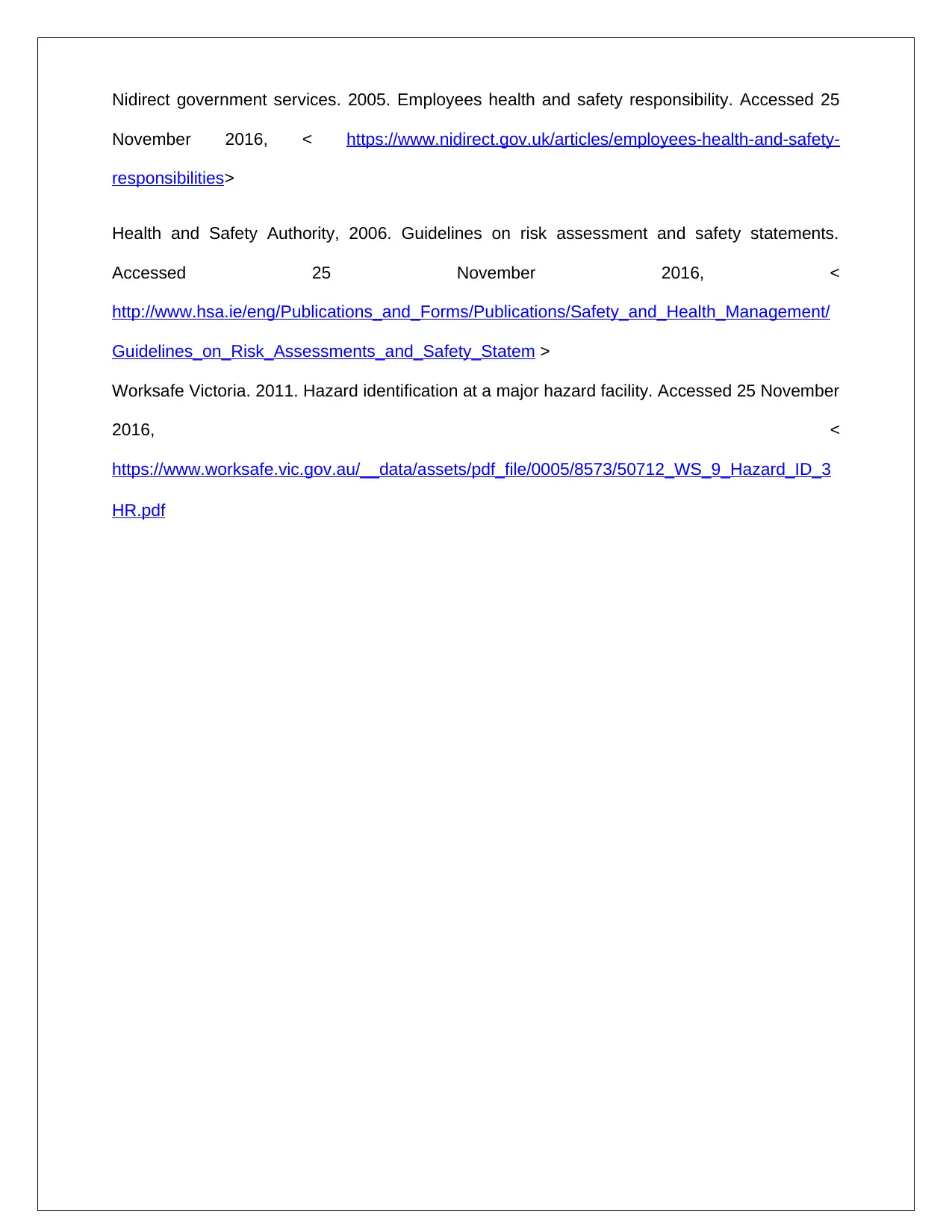
Nidirect government services. 2005. Employees health and safety responsibility. Accessed 25
November 2016, < https://www.nidirect.gov.uk/articles/employees-health-and-safety-
responsibilities>
Health and Safety Authority, 2006. Guidelines on risk assessment and safety statements.
Accessed 25 November 2016, <
http://www.hsa.ie/eng/Publications_and_Forms/Publications/Safety_and_Health_Management/
Guidelines_on_Risk_Assessments_and_Safety_Statem >
Worksafe Victoria. 2011. Hazard identification at a major hazard facility. Accessed 25 November
2016, <
https://www.worksafe.vic.gov.au/__data/assets/pdf_file/0005/8573/50712_WS_9_Hazard_ID_3
HR.pdf
November 2016, < https://www.nidirect.gov.uk/articles/employees-health-and-safety-
responsibilities>
Health and Safety Authority, 2006. Guidelines on risk assessment and safety statements.
Accessed 25 November 2016, <
http://www.hsa.ie/eng/Publications_and_Forms/Publications/Safety_and_Health_Management/
Guidelines_on_Risk_Assessments_and_Safety_Statem >
Worksafe Victoria. 2011. Hazard identification at a major hazard facility. Accessed 25 November
2016, <
https://www.worksafe.vic.gov.au/__data/assets/pdf_file/0005/8573/50712_WS_9_Hazard_ID_3
HR.pdf
1 out of 14
Related Documents
Your All-in-One AI-Powered Toolkit for Academic Success.
+13062052269
info@desklib.com
Available 24*7 on WhatsApp / Email
![[object Object]](/_next/static/media/star-bottom.7253800d.svg)
Unlock your academic potential
© 2024 | Zucol Services PVT LTD | All rights reserved.





